Maple Sugaring: Making Granulated Maple Sugar

I try to be as self-sufficient in as many areas as possible so I have a backyard Maple Sugaring set-up that I built using some old commercial equipment that I got real cheap. It's a small homesteading operation that provides me with more than enough maple syrup and maple candy for my yearly needs and for those of many others. This year I'm also making granulated Maple sugar to use as a replacement for some of the sugar I purchase each year. I'll be learning how to incorporate it as much as possible into my cooking so that I can one day become self-sustaining in my sugar needs. It's a very easy process and the results are a beautiful and tasty granulated sugar; my own sugar!!!
taken from The North American Maple Syrup Producers' Manual---page 188
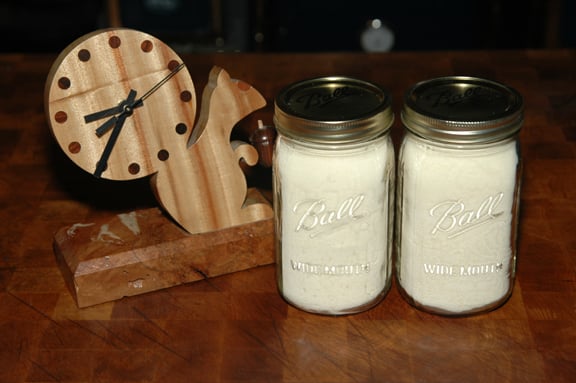
I try to be as self-sufficient in as many areas as possible so I have a backyard Maple Sugaring set-up that I built using some old commercial equipment that I got real cheap. It's a small homesteading operation that provides me with more than enough maple syrup and maple candy for my yearly needs and for those of many others. This year I'm also making granulated Maple sugar to use as a replacement for some of the sugar I purchase each year. I'll be learning how to incorporate it as much as possible into my cooking so that I can one day become self-sustaining in my sugar needs. It's a very easy process and the results are a beautiful and tasty granulated sugar; my own sugar!!!
taken from The North American Maple Syrup Producers' Manual---page 188
Loose Granulated Maple Sugar
Granulated maple sugar (sometimes called stirred sugar or Indian sugar) is prepared by heating maple syrup until the temperature is 45˚ to 50˚F (25˚ to 28˚C) above the boiling point of water. It is then allowed to cool to about 200˚F (93˚C), and stirred either in the cooking vessel or in an appropriately sized container until granulation is achieved. Stirring can be done by hand or by using a mechanical stirring machine. Granulated sugar will "breathe" and ride up high in the pan as it is stirred. A pause in stirring will cause it to drop back down again; after which stirring can be resumed. Stirring continues until all moisture is essentially removed from the cooked syrup and crumbly, granulated sugar remains, similar to commercially packaged brown sugar. At this point the sugar is sifted through a coarse screen (1/8-inch or 3mm hardware cloth is commonly used) to make a uniformly sized product. Stainless steel sieves with handles are available at restaurant supply stores. Granular sugar absorbs moisture and should quickly be stored in dry, airtight containers. A quart of syrup will yield about 2 pounds of granulated sugar; a liter of syrup about 1 kg of granulated sugar. Lighter colored (lower invert) syrup tends to make a "drier" finished product than if darker syrup is used.
Let's start!

First, heat your Maple Syrup to the boiling point of water plus 45° F. - 50° F.
The boiling point of water here at the ranch is 212° F.
I need to heat my Maple Syrup to be between 257° F and 262° F.

I'm cooking this in my summer kitchen because it can get messy.
I've reached my temperature target zone: 260° F.

Into the mixer...

The mixer is doing all the hard work.

You can see the consistency of the syrup is really starting to change.

It's lightening up and beginning to have that nice maple color.

It's about ready to vaporize!

When the syrup begins the final phase of turning into sugar
you'll have an explosion of steam as the water begins to evacuate.
The first time this happened to me I thought the motor on my mixer was on fire!

The last of the water is coming out now.
When there's no more steam rising, you're finished.

Done.
Notice the clumpy granulation.
It's about the consistency of store bought brown sugar but not as sticky.

Spread out and cooling down.

Sifting it into a little finer granulation.

A bowl full of sugar...

Finally, let your maple sugar cool completely down before packaging.

Maple Syrup & Granulated Maple Sugar
under the watchful eye of Knutz!
Granulated maple sugar (sometimes called stirred sugar or Indian sugar) is prepared by heating maple syrup until the temperature is 45˚ to 50˚F (25˚ to 28˚C) above the boiling point of water. It is then allowed to cool to about 200˚F (93˚C), and stirred either in the cooking vessel or in an appropriately sized container until granulation is achieved. Stirring can be done by hand or by using a mechanical stirring machine. Granulated sugar will "breathe" and ride up high in the pan as it is stirred. A pause in stirring will cause it to drop back down again; after which stirring can be resumed. Stirring continues until all moisture is essentially removed from the cooked syrup and crumbly, granulated sugar remains, similar to commercially packaged brown sugar. At this point the sugar is sifted through a coarse screen (1/8-inch or 3mm hardware cloth is commonly used) to make a uniformly sized product. Stainless steel sieves with handles are available at restaurant supply stores. Granular sugar absorbs moisture and should quickly be stored in dry, airtight containers. A quart of syrup will yield about 2 pounds of granulated sugar; a liter of syrup about 1 kg of granulated sugar. Lighter colored (lower invert) syrup tends to make a "drier" finished product than if darker syrup is used.
Let's start!
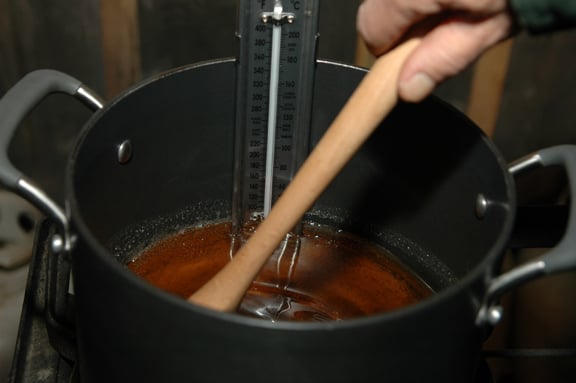
First, heat your Maple Syrup to the boiling point of water plus 45° F. - 50° F.
The boiling point of water here at the ranch is 212° F.
I need to heat my Maple Syrup to be between 257° F and 262° F.
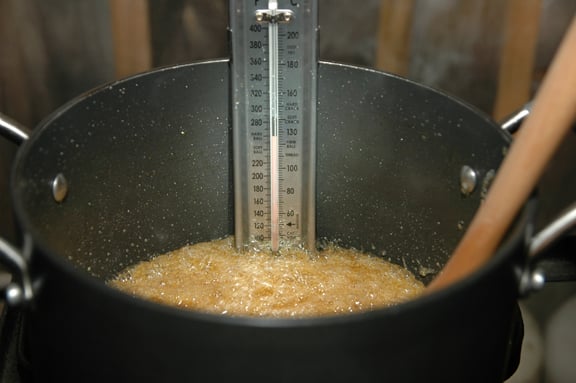
I'm cooking this in my summer kitchen because it can get messy.
I've reached my temperature target zone: 260° F.
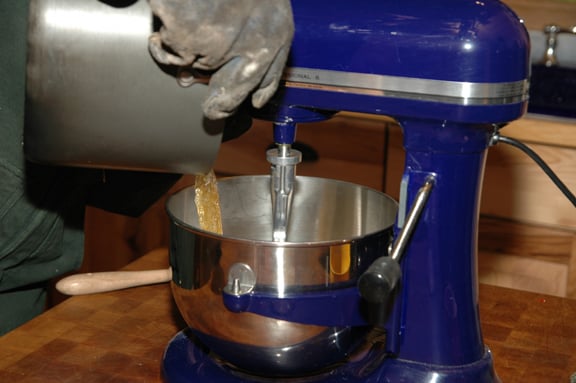
Into the mixer...
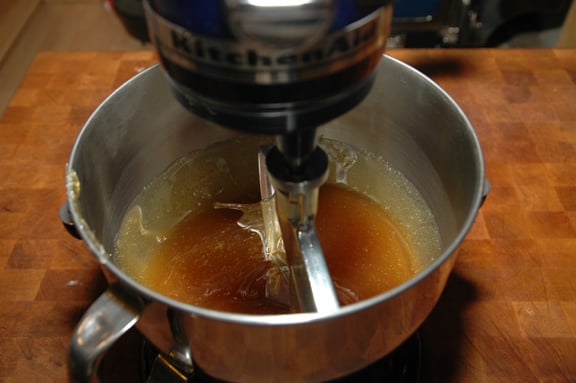
The mixer is doing all the hard work.
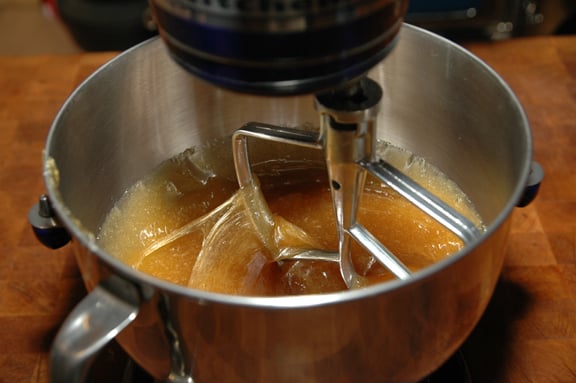
You can see the consistency of the syrup is really starting to change.
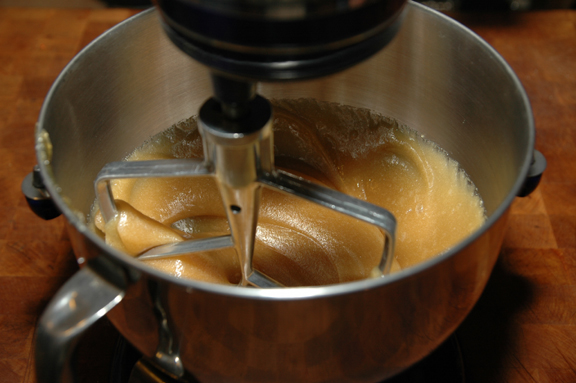
It's lightening up and beginning to have that nice maple color.
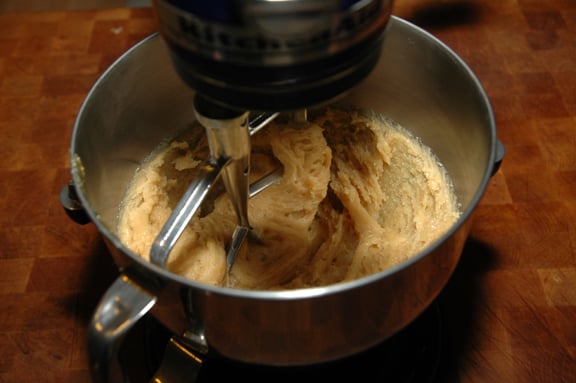
It's about ready to vaporize!
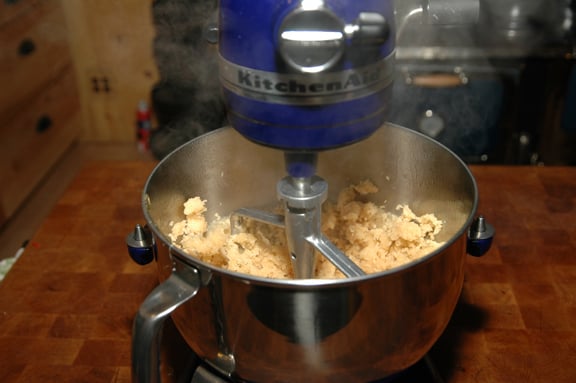
When the syrup begins the final phase of turning into sugar
you'll have an explosion of steam as the water begins to evacuate.
The first time this happened to me I thought the motor on my mixer was on fire!
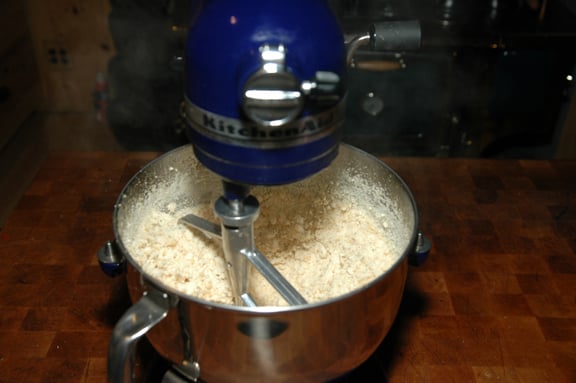
The last of the water is coming out now.
When there's no more steam rising, you're finished.
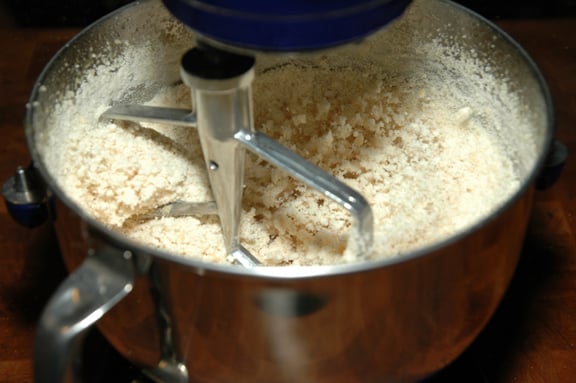
Done.
Notice the clumpy granulation.
It's about the consistency of store bought brown sugar but not as sticky.
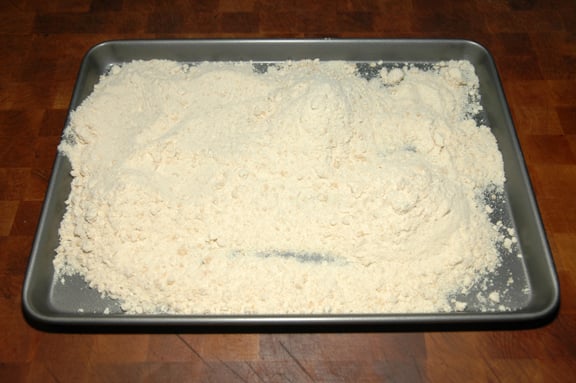
Spread out and cooling down.
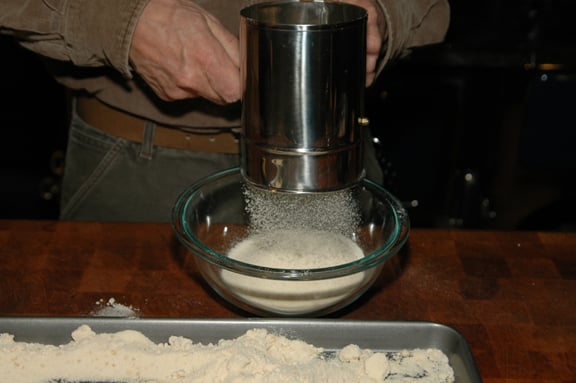
Sifting it into a little finer granulation.
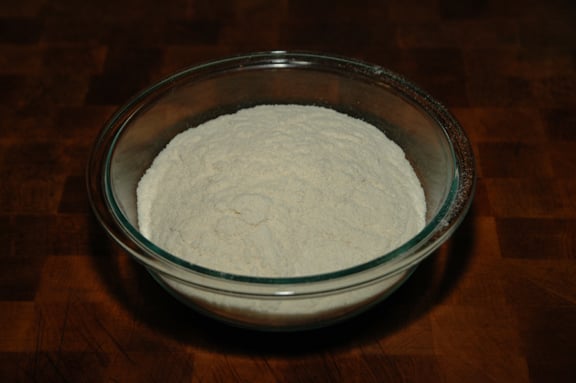
A bowl full of sugar...
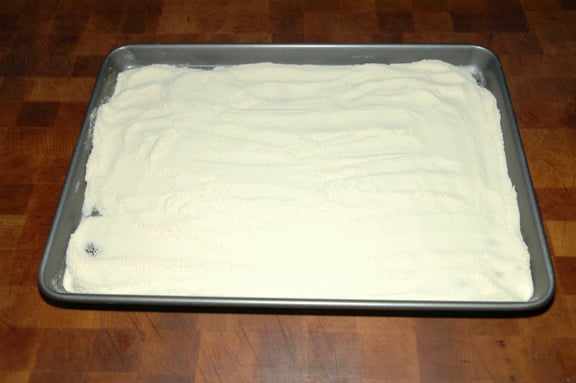
Finally, let your maple sugar cool completely down before packaging.
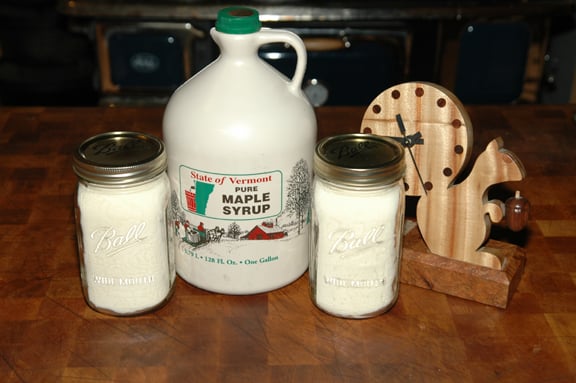
Maple Syrup & Granulated Maple Sugar
under the watchful eye of Knutz!


